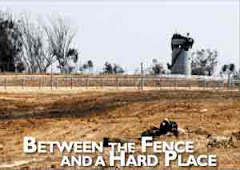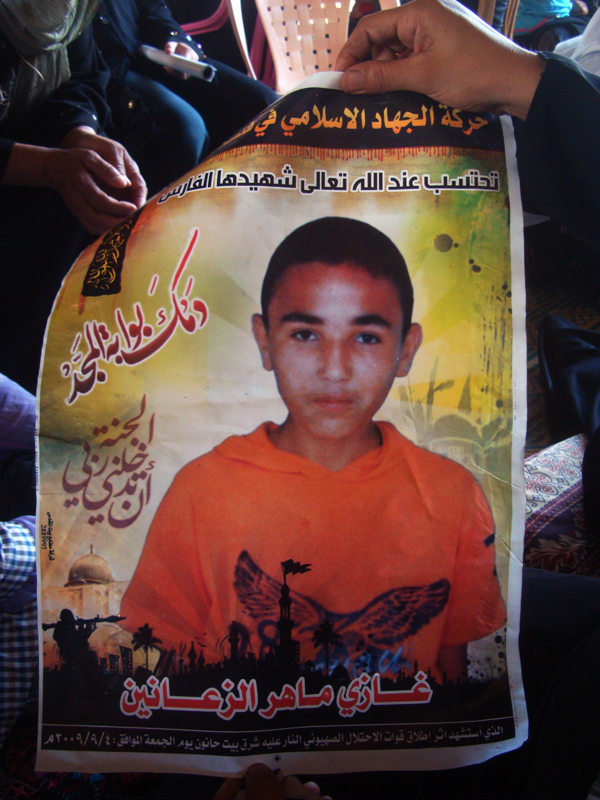21 August 2011 | Islam Online, Hama Waqum
On Nakba Day in May, thousands of Palestinians edged towards Israel’s borders with Syria, Lebanon, Jordan, Egypt and Gaza, demanding their Right of Return, and an end to the Israeli occupation. Many of these protestors would return to demonstrate on the Naksa Day in June.
A major demand put forth by the Gazan demonstrators was the elimination of the ‘buffer zone’, which forbids Palestinians from stepping within three hundred meters of the cement wall that separates Gaza from the outside world.
Farming beyond the Buffer Zone
Gaza’s farmers face dangers in tending to their land, even if it lies beyond the ‘buffer zone’. For this reason, Palestinians and internationals arrange and attend mass farming events where they harvest and plant en masse.
In June, around 200 Palestinian men and women gathered in a small farm outside of Beit Hanoun, northern Gaza. Scrambling through a wheat field to a freshly-ploughed meadow, volunteers from all backgrounds assembled to help the owner of the farm to sow tomato and aubergine plants in the fields closest to the ‘buffer zone’. The three hundred meters of farmland adjacent to the wall is left unfarmed year-round. Those taking a break from crouching in the soil would stand up only to see an Israeli observation balloon, suspended above the horizon beyond the Israeli barrier.
Wisam, a student from Gaza City volunteered, along with several grandfathers, niqabi mothers and international activists. “We came here because we must stand in solidarity with the farmers who are trying to work their land” she explained.
With many hands at work, the land is freshly graced with green saplings in less than two hours and planting time is reduced, which lowers the risks posed to farmers who would otherwise spend days in front of the military outposts planting the saplings.
Farming at gun point
Father-of-six, Jabr Abu Jala lives in the ‘high-risk’ or ‘danger’ zone, meters away from the border in Faraheen, near Khan Younis in southern Gaza. It is farms such as Abu Jala’s that request assistance, so that planting and harvesting can be carried out as quickly as possible, with no intimidation from the nearby military outposts. “We face attacks and shooting almost daily.” Abu Jala explained, “Some days it’s calm, some days it’s not, but, regardless, we are forbidden from tending to a large section of our farmland- and this is a direct result of the occupation.
“They say that the buffer zone is 300 meters, so why do people end up getting shot at when they are 800 meters away from the barrier?”
Nathan Stuckey is an American activist, who had been helping to harvest Abu Jala’s wheat yield and occasionally staying with the family on their farm.
“Last night I was lying in bed, (it was) at about 5:00am and we started hearing a lot of shooting from the north and east sides of Faraheen. It was coming from the towers or Jeeps close to the farmland, right on the border” he said explaining a frequent occurrence. In the village Khozaa, it’s too dangerous for men to come to the field; the Israelis are less likely to shoot women, so that’s why the women do the farm work” he added.
Women till the soil
Despite the conservative nature of Gazan society—which is particularly apparent in smaller farming villages—it is equally acceptable for men and women to tend to land.
Halima is a Gazan mother who tends to a farm at Faraheen, “Many women farm here, we love to work. I’m the only woman here today, because I come to watch over my sons who are harvesting. I worry about their safety. If internationals weren’t here to harvest with us, we’d have to stop at 8 or 9am. If we farm in the evening, we die!” she said, laughing.
Sarah is a student of biology at Al Aqsa University who joined the 200 Palestinians in the planting of saplings in northern Gaza.
“I came here to help the farmers sow their seeds,” she explained, “It is important for women to help in this aspect. As women, we don’t face any trouble coming here to work alongside the men, you can see for yourself that it’s normal; nobody minds.”
20-year old Anwar took part in the Beit Hanoun demonstrations on the ‘Naksa’—or setback—day, near the Erez crossing. “We are here to protest against the occupation in the West Bank and Gaza and in memory of our heritage. We have come here with saaj (traditional bread), Palestinian coffee and dress, and dabka dancers to protest. This is a cultural demonstration.”
Palestinians in Gaza have become creative in their defiance of the ‘buffer zone’, from holding cultural parties to commemorate the Naksa, to flying kites over the forbidden land with messages to Israeli citizens. But, what is most pressing is their desire to be able to farm on their own land without being harassed by Israeli outposts. When large groups are able to mobilize and harvest a field in a couple of hours, this becomes much easier. Sadly, not all farms have access to a network of support and volunteers such as this.
On Nakba Day in May, thousands of Palestinians edged towards Israel’s borders with Syria, Lebanon, Jordan, Egypt and Gaza, demanding their Right of Return, and an end to the Israeli occupation. Many of these protestors would return to demonstrate on the Naksa Day in June.
A major demand put forth by the Gazan demonstrators was the elimination of the ‘buffer zone’, which forbids Palestinians from stepping within three hundred meters of the cement wall that separates Gaza from the outside world.
Farming beyond the Buffer Zone
Gaza’s farmers face dangers in tending to their land, even if it lies beyond the ‘buffer zone’. For this reason, Palestinians and internationals arrange and attend mass farming events where they harvest and plant en masse.
In June, around 200 Palestinian men and women gathered in a small farm outside of Beit Hanoun, northern Gaza. Scrambling through a wheat field to a freshly-ploughed meadow, volunteers from all backgrounds assembled to help the owner of the farm to sow tomato and aubergine plants in the fields closest to the ‘buffer zone’. The three hundred meters of farmland adjacent to the wall is left unfarmed year-round. Those taking a break from crouching in the soil would stand up only to see an Israeli observation balloon, suspended above the horizon beyond the Israeli barrier.
Wisam, a student from Gaza City volunteered, along with several grandfathers, niqabi mothers and international activists. “We came here because we must stand in solidarity with the farmers who are trying to work their land” she explained.
With many hands at work, the land is freshly graced with green saplings in less than two hours and planting time is reduced, which lowers the risks posed to farmers who would otherwise spend days in front of the military outposts planting the saplings.
Farming at gun point
Father-of-six, Jabr Abu Jala lives in the ‘high-risk’ or ‘danger’ zone, meters away from the border in Faraheen, near Khan Younis in southern Gaza. It is farms such as Abu Jala’s that request assistance, so that planting and harvesting can be carried out as quickly as possible, with no intimidation from the nearby military outposts. “We face attacks and shooting almost daily.” Abu Jala explained, “Some days it’s calm, some days it’s not, but, regardless, we are forbidden from tending to a large section of our farmland- and this is a direct result of the occupation.
“They say that the buffer zone is 300 meters, so why do people end up getting shot at when they are 800 meters away from the barrier?”
Nathan Stuckey is an American activist, who had been helping to harvest Abu Jala’s wheat yield and occasionally staying with the family on their farm.
“Last night I was lying in bed, (it was) at about 5:00am and we started hearing a lot of shooting from the north and east sides of Faraheen. It was coming from the towers or Jeeps close to the farmland, right on the border” he said explaining a frequent occurrence. In the village Khozaa, it’s too dangerous for men to come to the field; the Israelis are less likely to shoot women, so that’s why the women do the farm work” he added.
Women till the soil
Despite the conservative nature of Gazan society—which is particularly apparent in smaller farming villages—it is equally acceptable for men and women to tend to land.
Halima is a Gazan mother who tends to a farm at Faraheen, “Many women farm here, we love to work. I’m the only woman here today, because I come to watch over my sons who are harvesting. I worry about their safety. If internationals weren’t here to harvest with us, we’d have to stop at 8 or 9am. If we farm in the evening, we die!” she said, laughing.
Sarah is a student of biology at Al Aqsa University who joined the 200 Palestinians in the planting of saplings in northern Gaza.
“I came here to help the farmers sow their seeds,” she explained, “It is important for women to help in this aspect. As women, we don’t face any trouble coming here to work alongside the men, you can see for yourself that it’s normal; nobody minds.”
20-year old Anwar took part in the Beit Hanoun demonstrations on the ‘Naksa’—or setback—day, near the Erez crossing. “We are here to protest against the occupation in the West Bank and Gaza and in memory of our heritage. We have come here with saaj (traditional bread), Palestinian coffee and dress, and dabka dancers to protest. This is a cultural demonstration.”
Palestinians in Gaza have become creative in their defiance of the ‘buffer zone’, from holding cultural parties to commemorate the Naksa, to flying kites over the forbidden land with messages to Israeli citizens. But, what is most pressing is their desire to be able to farm on their own land without being harassed by Israeli outposts. When large groups are able to mobilize and harvest a field in a couple of hours, this becomes much easier. Sadly, not all farms have access to a network of support and volunteers such as this.



